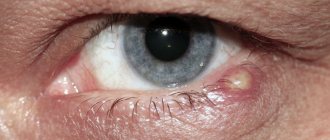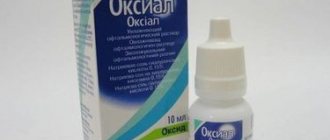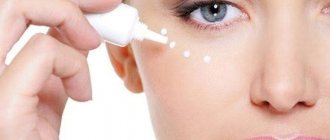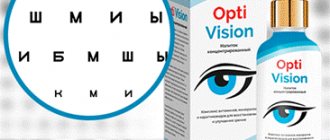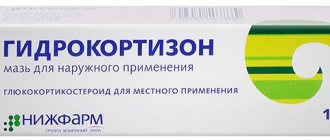Classification of burns
There is no single generally accepted classification for eye burns. They are usually divided according to the type of damaging factor, location and depth of damage.
Depending on the characteristics of the damaging factor, burns are divided into chemical, radiation and thermal. In cases where there are several influencing factors, a thermochemical burn develops.
Based on the location of the lesion, it is customary to distinguish burns of the eyelids, cornea, conjunctiva, choroid, retina, and lens.
According to the depth of damage, eye burns come in 4 degrees of severity (according to Polyak). The mildest is a first degree burn, its outcome is favorable in almost 100% of cases. More severe degrees (II – IV) of eye burns are treated only in a hospital; the consequences of such a lesion are sometimes extremely severe.
Symptoms
The depth and extent of the burn, as well as the period that has passed since the injury to the eye, are decisive when the patient complains. Symptoms of a burn are usually as follows:
- The skin of the eyelids is swollen and red.
- There is severe pain and irritation of the eyes.
- Swelling and hyperemia of the eye mucosa (conjunctiva, cornea) develops
- Watery eyes and photophobia occur.
- A violation of the transparency of the cornea is detected.
- Visual acuity decreases, visual fields narrow.
- There may be an increase or decrease in pressure inside the eye.
Radiation burns often do not cause some of these symptoms, since infrared or laser beams primarily affect the cellular tissue of the choroid and retina.
It is worth remembering that the severity of the injury cannot always be determined immediately after an eye injury. A victim with an eye burn, regardless of its severity, must be urgently transported to a medical facility, where he will be shown to a specialist. Often, the prognosis of the disease is directly related to the speed and volume of specialized care.
Thermal burns
Thermal are eye burns that occur when exposed to high or extremely low temperatures, including exposure to hot liquids, fire, steam, burning or hot solid particles, dry ice, as well as cryogenic liquids and liquefied gases. Such burns, as a rule, are localized in the anterior part of the eye, and damage to the deep ocular structures can be observed only in severe cases.
If a thermal burn occurs, traces of the traumatic substance should be removed if possible and the eyes should be rinsed under a weak stream of water. The skin around the eye is lubricated with an antiseptic or antibiotic ointment (for example, tetracycline ointment), the same ointment should be placed behind the eyelid. The eye is covered with an aseptic bandage, and scratching or rubbing it is strictly prohibited. The patient is hospitalized as quickly as possible.
Chemical burns
Chemical burns to the eyes are usually caused by exposure to acids or caustic alkalis. In everyday life, they are caused by the ingestion of crystals of potassium manganese, ammonia, iodine, lime, various cosmetics, and household chemicals.
The peculiarity of chemical burns is the duration of exposure to the damaging factor. After all, when alkali, for example, gets into the eye, it can damage not only the tissues localized at the point of direct contact, but also penetrate into the deep parts of the eye.
If chemical agents come into contact with the eyes, they must be immediately rinsed under a weak stream of water (at least 10 - 15 minutes, until traces of this substance disappear from the eye). Then, you need to put antiseptic eye drops into your eyes, and lubricate the skin around with antiseptic ointment. After which it is better to cover the affected eye with an aseptic bandage and send the victim for an ophthalmological examination.
Harm from lime water
Lime water has long been used in folk medicine, but, like all means that affect the body, it cannot be used in all cases and not by all people. Let's talk about the dangers and benefits of lime water.
What is the benefit
Since lime solution is rich in calcium, it is often used for:
- treatment of skin diseases: eczema, ulcers and rashes;
- accelerating the healing of wounds from burns, abrasions, scratches and other skin damage. This is achieved thanks to the antibacterial and anti-inflammatory properties of slaked lime.
- treatment of abscesses and pustules use a mixture of lime with warm vegetable oil: make compresses that help get rid of pus in a few hours;
- getting rid of lichen, candidiasis and other fungal diseases.
- Treatment of hemorrhoids - you can do sitz baths with lime water. The procedure is performed 10–12 times, after which the disease subsides.
- stopping diarrhea in a baby - lime water can be added to milk;
- getting rid of constipation - make cleansing enemas from ordinary and lime water in a 2:1 ratio;
- treatment of gynecological diseases, for example, uterine fibroids. In this case, lime water is taken orally for two weeks, one teaspoon 3 times a day;
- reducing stomach acidity;
- treatment of bladder diseases - irrigate it with a weak solution of lime water;
- replenishing calcium in pregnant women - women take the solution orally;
- eliminate teenage rashes on the face - it is recommended to wash with lime water. This is also a good product for gentle skin care of young children.
What harm can you do?
In addition to the positive effects on the body, the use of drinking water with lime can have negative consequences:
some experts believe that lime water can reduce immunity;
- calcium, which is part of drinking water, can be deposited in the form of salts, forming sand and kidney stones;
- excessive calcium consumption can trigger the development of vascular sclerosis and arthritis;
- lime can lead to exacerbation of chronic diseases, such as gastritis;
- calcium particles can provoke disruption of the digestive system, causing nausea and vomiting;
- External use of too concentrated lime water can lead to blockage of pores on the surface of the skin, which will lead to the appearance of redness and pustules.
In some cases and certain categories of people, eating food cooked in lime water is prohibited:
- With high cholesterol. Calcium ions that are not absorbed by the body are attracted to cholesterol plaques. The resulting structures are deposited on the walls of blood vessels, which leads to their blockage.
- For arthritis and arthrosis, high blood pressure.
- When there is damage to the digestive tract, for example, with gastritis;
- Vegetarians, professional athletes and anyone who has a non-standard acid-base balance.
Lime water can rightfully be called controversial, because it can have both negative and positive effects on the human body at the same time.
- As mentioned above, lime water is distinguished by the presence of a huge amount of various salts, magnesium and calcium. If you use such a solution three times a day, even in seemingly insignificant quantities, you may soon experience pain in the kidneys due to the appearance of sand there, which in the future can lead to the formation of stones. This does not give the most encouraging forecasts.
- The cause of such common diseases as arthritis, stomach ulcers and sclerosis may partly be hidden in the frequent use of lime water without a doctor’s prescription.
- Water containing a lot of lime is impractical to use, and the reason for this is the high concentration of calcium salt.
- With frequent use, lime water can weaken the body's protective functions, contribute to metabolic disorders and negatively affect the gastrointestinal tract.
- When interacting with detergents, calcium ions are poorly washed off from human skin, which causes clogged pores and acne.
- Also, calcium ions, as a result of contact with household products, leave cleaning marks and stains on the surface of plumbing fixtures and dishes.
- Due to the strong concentration of lime in the water, specific deposits appear in the pipes, which limit the throughput of the plumbing.
Radiation burns
Depending on the type of damaging factor, radiation burns to the eyes may have some characteristics. Such burns occur from exposure to short-wave (UV rays) or long-wave (infrared rays) radiation. Especially often, such damage is detected after visiting solariums, at ski resorts (snow ophthalmia or blindness), and among electric welders.
Radiation burns appear only after a few hours (after about 4 - 6 hours), while typical complaints are: severe pain in the eyes, photophobia, lacrimation, sharp deterioration of vision due to damage to the retina. As with other eye burns, with radiation injuries the patient needs immediate help. What are pain-relieving eye drops (“Inocain”), corticosteroids (“Hydrocortisone ointment”, “Dexamethasone”), drugs that relieve local swelling and oil vitamin solutions (“VitA-Pos”), antibacterial drugs (“Floxal”, ( "Levomycetin").
Actions after removal
Even a small speck can cause serious harm. Therefore, after removing it, it is necessary to examine the eye in good daylight.
In case of redness or swelling, you should:
- Instill drops of antibacterial action: “Tobrex”, “Floxal”, “Tsiprolet”. They relieve inflammation and prevent the development of infectious eye diseases.
- Use eye drops such as Taufon or Albucid. They eliminate eye redness and promote rapid healing of the cornea.
In addition to drug therapy, traditional medicine methods can be used to relieve discomfort:
- The eyes are washed with strong black tea. A cotton pad is generously moistened with warm tea leaves and wiped over the eyes. A separate disk is used for each.
- Three times a day, one drop of infusion of sage, chamomile or calendula is instilled.
- Place a freshly cut cucumber or potato slice on closed eyelids and leave for twenty minutes.
- Dissolve a little honey in a tablespoon of boiled water. Moisten a cotton pad with the resulting solution and wipe your eyes.
Traditional medicine methods are applicable only if the foreign body is removed without complications.
Treatment of eye burns
First aid provided for eye burns, regardless of the type of burn, should be aimed at eliminating the damaging agent (chemical, temperature or radiation), applying antibacterial eye drops (Levomycetin, Albucid, Sodium Sulfacyl, etc.), laying ointments (“Tetracycline ointment”, “Floxal”). This is done to prevent the development of secondary infection in damaged eye tissues. Then, as a rule, a sterile bandage is applied to the eye and the victim is taken to the hospital.
Treatment of eye burns should only be carried out by an ophthalmologist. The choice of necessary drugs, the frequency of their application and the duration of use depend on the type of burn, its degree, and other individual factors.
Is whiteness chlorine?
Many housewives call white chlorine due to the presence of a specific aroma - how correct is this? If you study the chemical composition of the disinfectant in question, you can find sodium hypochlorite in it - this is the active element of whiteness, containing active chlorine in an amount of 95% of the total mass of sodium hypochlorite. Therefore, we can say for sure that the familiar whiteness is real chlorine - this chemical can lead to severe poisoning if used incorrectly and if safety rules are not followed.
Did you know that even a slight inhalation of chlorine vapor can lead to disruption of all body systems? Of course, chlorine vapor must enter the body in large quantities, but, for example, for a child it will be enough to simply actively sniff the white from the bottle for symptoms of poisoning to appear. And adults, at times, show amazing carelessness - whiteness gets on the skin and in the eyes, it is swallowed, which invariably leads to a condition that will require medical intervention.
Consequences and prognosis
The consequences of eye burns are determined by the depth of damage, the type of damaging factor, the severity of tissue damage and the timeliness of treatment.
Burn injuries to the eyes of II – IV degrees are accompanied by certain complications and do not go away without leaving a trace. In the tissues of the eye, scarring may occur, disruption of the lacrimal ducts, decreased transparency of the cornea, development of dry eye syndrome, cataracts or glaucoma. The outcome of burns can be damage to retinal cells in the macular area and the occurrence of irreversible blindness.
In the medical department, everyone can undergo examination using the most modern diagnostic equipment, and based on the results, receive advice from a highly qualified specialist. The clinic is open seven days a week and operates daily from 9 a.m. to 9 p.m. Our specialists will help identify the cause of vision loss and provide competent treatment for identified pathologies.
You can make an appointment at the Moscow Eye Clinic by calling 8 8 (499) 322-36-36 (daily from 9:00 to 21:00) or using the online registration form.
Dagaev Adam Huseinovich
Complications
Primary complications include: conjunctivitis, corneal erosion, corneal opacification and edema, acute increase in IOP, corneal melting and perforation.
Secondary complications may be: • secondary glaucoma; • secondary cataract; • scarring of the conjunctival cavity; • thinning of the cornea, perforation; • corneal ulcer (aseptic or infectious nature); • complete disruption of the surface, clouding and vascularization of the cornea; • subatrophy of the eyeball (phthisis).
Author
: Ophthalmologist P. S. Zaitsev, Kovrov, Russia.
Date
of publication (update): 01/31/2019


